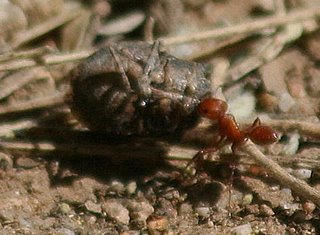On Tuesday, jimmy posted some lovely
photos of tiny crab spiders on his blog. As I was wandering about in the back yard looking for a bird or two to photograph, I was thinking about jimmy’s post and realizing that I hadn’t sought out any small creatures to study or photograph in recent weeks. That’s when I spotted this
Red Fire Ant dragging home its enormous prey. Of the six species of
Fire Ant, three are known in
Arizona: the southern fire ant (
S. xyloni), and two species of desert fire ant (
S. aurea and
S. amblychila). Fire ants are considered beneficial insects because they feed on other unwanted pests such as fleas, filth breeding flies, horn flies, boll weevils, sugarcane borer, ticks, and cockroaches.

I don’t know what species this hard worker belongs to, but I do know from past experience that it can deliver an excruciating sting when it bites. I kept well out of its way. In addition to the queen, fire ant colonies consist of major workers (up to 1/3 inch in length) and minor workers (up to about 1/10 inch). This one was a major worker. I watched the ant working hard to drag its prey across the rough terrain. Suddenly it dropped the load, climbed up on it and surveyed the area,

then calmly walked away and left it.

I'm still wondering why, after all that hard work, it abandoned the project.




8 comments:
They do work so hard and carry heavy loads. I've often been surprised by how much they try to haul. I do recall being bitten by a red ant once. It left quite a nasty welt. Nice photographs.
One of the cool things about ants is that their world, is dominated by chemicals. In essence they taste or smell the world around them. EO Wilson wrote about an experiment in which they isolated a particular species' chemical trigger for dead ant. Putting some of the chemical on a live ant caused other ants to pick it up and carry it to the refuse pile, at which point it would get up and try and walk back into the colony, only to be continually carried to the dump until the smell wore off.
Perhaps she sensed a better opportunity, either that or it was coffee break.
nice photos, indeed! How the heck do you do it?
Hey Pam,
I was so glad to read that they are actually beneficial because I thought they were invasive species causing quite a few problems besides stings. Having spent a large part of my life in Texas, I know them well (not species, just face to face or tail to foot--did you know they hold with their teeth and sting with the butts?) and the many concotions people unaware of the dangers of pesticides will create to combat them.
jimmy - yeah, they can be pretty mean. I've been bitten a couple of times; it wasn't fun.
rd - I love to watch ants working. They have amazing strength and perseverance.
clare - Thanks for the EO Wilson story. That's fascinating. Coffee break? Maybe!
tdharma - Thanks! It's still beginners luck, I confess.
lené - There is an invasive variety: the Red Imported Fire Ant (RIFA). They came in from Brazil. They're aggressive and destructive. I think this ant is a local, though.
I definitely think those are the ones I knew in Texas. Thanks for the link.
I believe that's actually a Pogonomyrmex worker (harvester ant). People commonly call them fire ants because they have an extremely painful sting. Our native fire ants (genus Solenopsis) are much much smaller, with a rounded petiole, and are very nice ants as you note. We do not have the invasive fire ant S. invicta in Tucson, because it is too hot and dry! In fact, the only invasive ant we have that I know of is a tiny and relatively harmless Brachymyrmex.
For future note, S. xyloni is red and black or all black, S. aurea is generally red, and S. amblychila is also red but more nocturnal. They can be difficult to key out.
-A local ant fan
local ant fan - Welcome to my blog. Thank you so much for the identification. I looked up the harvester ant on the Internet and enjoyed reading about it. I haven't paid much attention to ants before, except to try to avoid red ones because their bites are quite painful. The swarm of ants we had yesterday (posted today - July 29) was pretty spectacular though.
Post a Comment